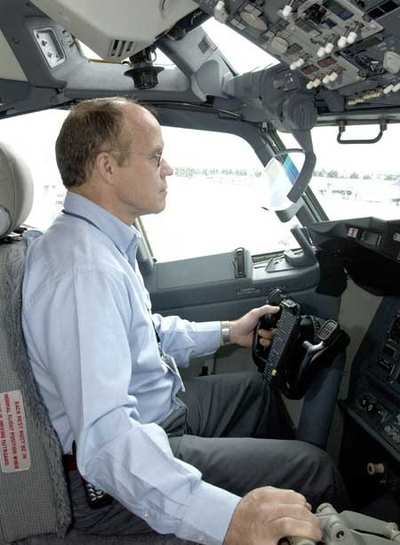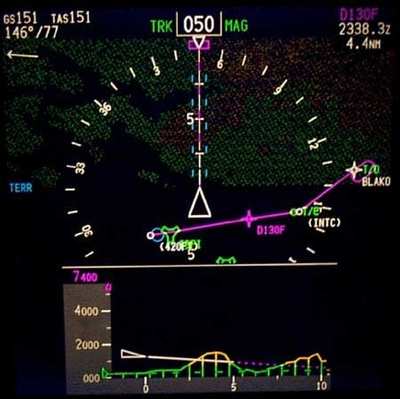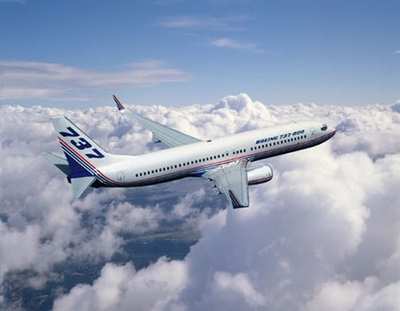Boeing's Workhorse 737 Keeping Up With The Times
Imagine waiting in the
terminal for your flight to depart San Francisco International
Airport when suddenly, a thick blanket of fog rolls down from the
bay and envelops the airport. Visibility is cut to 300 feet. The
word "delayed" starts to scroll across departure monitors. Your
flight on a Boeing Next-Generation 737, however, leaves on time,
thanks to state-of-the-art flight deck technology.
At a time when increased security screenings lengthen the time
it takes to travel, The Boeing Company continues to develop new
technologies that promise to reduce flight delays and enhance
safety and flight-crew efficiency. Nowhere is that more apparent
than on the Next-Generation 737.
The airplane is the most popular commercial jetliner ever built.
More than 4,000 737s have carried about 7 billion people -- more
than the equivalent of the world's population. In fact, every 5.3
seconds a 737 takes off or lands somewhere in the world.
The newest members of the 737 family -- the
737-600/-700/-800/-900 models -- entered into service just five
years ago after a technology makeover. The digitally designed 737s
are outfitted with larger wings and more powerful engines, which
allow them to fly higher, faster and farther than previous models
and its competitor. In addition, the new flight deck features
advanced programmable software and liquid-crystal flat-panel
displays, not available on competing models.
Cutting through the fog
A Boeing Next-Generation 737 equipped with the Head-Up Display
(HUD) flight deck system allows the airplane to fly when others
cannot. Some regulatory standards require a minimum of 600 feet of
visibility before an airplane is allowed to takeoff. Airplanes with
HUD can takeoff in visibility conditions as low as 300 feet. An
example of the 737's leading-edge technology is a sophisticated
system called Head-up Display or HUD. Although HUD has been used on
military aircraft for several years, the 737 is the only large
commercial jetliner produced today with this capability.
HUD uses a transparent glass display positioned between the
pilot's eye and the flight deck window to show critical information
such as airspeed, altitude, attitude and flight path. During
takeoffs and landings, an image of the runway is superimposed over
the actual view out the window.
The technology can eliminate flight cancellations, diversions
and delays caused by restricted visibility. It also provides an
extra margin of safety by allowing a pilot to keep his or her eye
"on the road," rather than looking down at the instrument panels.
The ability to present data in real-world context makes it easier
for pilots to take in information and fly the airplane, according
to 737 Chief Pilot Ray Craig.
"As a pilot, it can be somewhat difficult to land at an airport
at night or during low-visibility conditions with a high workload,"
Craig (seen below) said. "Without having to do any extra
calculations, I have all the important data I need to fly an
approach under those conditions. That allows me to focus on landing
the airplane safely."

This extra margin of safety allows a HUD-equipped airplane to
fly when others cannot. Some regulatory standards require a minimum
of 600 feet of visibility before an airplane is allowed to takeoff.
Airplanes with HUD can takeoff in visibility conditions as low as
300 feet (91 meters).
Alaska Airlines was the first to incorporate HUD across its
Next-Generation 737 fleet.
"We fly into many destinations where fog, reduced visibility and
strong winds combine to restrict our system schedule," said Captain
Paul A. Majer, Alaska Airlines System chief pilot. "The HUD
technology enhances our capability to depart an airport with
reduced visibility and helps us get our passengers to their
destinations as scheduled. HUD has been a tremendous benefit to
safety overall and, specifically, our ability to operate safely
despite reduced visibility conditions."
I can see for miles and miles
Pilots get a clear view of the airplane's current and predicted
flight path with the Boeing Next-Generation 737's new Vertical
Situation Display, which is shown in the lower part of the screen.
The system constantly monitors the airplane's flight path,
calculating the airplane's altitude, speed and position, and
portrays the information in an integrated and easily understood
graphical display. The airplane is represented by the triangle in
the display. Another advancement in the flight deck is Vertical
Situation Display (VSD). This high-tech marvel builds on the
Enhanced Ground Proximity Warning system and gives pilots a clear
view of the airplane's current and predicted flight path.

The ability to see the predicted flight path provides an earlier
warning of conflicts with terrain or an overshoot of the runway.
The same data exists in flight decks today, but the pilot needs to
mentally integrate the data from several sources. VSD does this
automatically and instantaneously.
The system constantly monitors the airplane's flight path,
calculating the airplane's altitude, speed and position, and
portrays the information in an integrated and easily understood
graphical display. Traditional flight deck displays give pilots a
bird's-eye view of an airplane's position relative to the rest of
the world.
"VSD gives the pilot a side view of the world, because people
think in those terms. It adds a normal perspective for a pilot and
increases situational awareness," said Ken Hiebert, Boeing Product
Marketing regional director.
Earlier this year, Australian carrier Virgin Blue became the
first airline to use VSD.
"The Next-Generation 737 is one of the best, if not THE best
aircraft in the world in terms of technology," said Capt. Steve
Knudsen, Virgin Blue's Flight Operations technical manager. "The
new Vertical Situation Display provides pilots with yet another
tool to monitor the aircraft's flight path. It is a valuable safety
enhancement."
Re-writing air traffic rules
But predicting the flight path is not just important for
avoiding mountaintops. VSD can provide an assurance that the
airplane will be at a certain point in space at a certain point in
time. That degree of accuracy can help rewrite air traffic rules
and increase air space capacity, something that is desperately
needed in crowded skies over Europe, the United States and other
parts of the world.
In today's air traffic system, airplanes approaching airports
tend to stack up in the sky, waiting to get to the gate. It's
similar to cars slowing down as they approach a traffic light. If
cars have to start slowing down two blocks away, traffic slows to a
crawl. Essentially, the same thing happens in the sky. Because
today's system can't ensure an airplane's precise position, air
traffic controllers require a certain amount of time and distance
between airplanes. VSD can change all that.
"VSD should enable us to shrink the air space between airplanes
and increase air space capacity because you can count on airplanes
being exactly where they are supposed to be. And if we can move
airplanes through air space more efficiently, we can add more
flights and passengers will have more choices," Craig said.
Highway in the sky
Another flight deck system that enhances the ability of the
pilot to monitor the precise position of an airplane and its
relation to the desired flight path is called Navigation
Performance Scales (NPS). The system incorporates global
positioning satellite technology to pinpoint and display the
precise position of the airplane in an easily understood graphical
display.
Boeing 737 Chief Pilot Ray Craig views critical flight information
on the transparent glass Head-Up Display (HUD), which is positioned
between the pilot’s eye and the flight deck window. The
technology can eliminate flight cancellations, diversions and
delays caused by restricted visibility, and it allows a pilot to
keep his or her eye “on the road,” rather than looking
down at the instrument panels. Think of a traffic lane in the sky.
NPS can tell you how close you are to the edge of the lane within
15 feet. With such accuracy, an airplane can safely navigate
through crowded skies, mountainous terrain and noise sensitive
areas. Like VSD, the NPS also opens up air space around
airports.
"We're setting a new standard for graphic depiction and
situation awareness," Hiebert added. "When the world goes to a
tighter airspace system, you don't want pilots trying to figure out
the airplane's position while moving at 450 knots. While you're
trying to calculate that, you can move miles. NPS can tell you
where you are instantly."
Technology earns its wings
The most obvious piece of advanced technology rests outside of
the 737 -- on the wings to be more specific. Visually distinctive
blended winglets gently curve out and up from the wings. Unlike
traditional winglets that attach at abrupt angles to the wing, the
8-foot (2.4 meters) high blended winglets add about 5 feet to the
airplane's total wingspan.
Blended winglets reduce aerodynamic drag and allow the 737 to
fly farther and quieter while burning up to 6 percent less fuel.
Given the price of fuel these days, the blended winglets provide
airlines significant savings, which can be passed along to the
passenger in the form of lower ticket prices.

More than 28 airlines currently fly nearly 300 737s equipped
with blended winglets, and more are on the way. Southwest Airlines,
one of the most successful carriers in the world, will begin
installing the sleek winglets on its newer 737s this fall.
"Southwest, the industry's low-cost provider, is keen on finding
innovative ways to keep our operating costs in check so we can
continue to provide low fares to millions more Americans," said
Laura Wright, Southwest's vice president of Finance. "This
technology is one way we can gain efficiencies in our operation and
save money while we grow."
Besides lowering operating costs, blended winglets help
airplanes fly from hot climate airports like Phoenix International
Airport, where temperatures can climb to 110 degrees Fahrenheit (43
Celsius), or from high-altitude airports like La Paz in Bolivia,
which is 13,320 feet (4,060 meters) above sea level. Both high and
hot conditions can limit the number of passengers or cargo boarding
a flight.
Just how do blended winglets help? Quite simply, airplane
engines, like human lungs, need oxygen to work effectively. For an
engine, the thinner the air -- as is the case at high altitudes or
in extremely hot weather -- the harder it is to create combustion
or power. To compensate, you need to create more lift with a bigger
wing. Without more lift, an airline is sometimes forced to restrict
the number of passengers or the amount of cargo on the flight.
Because blended winglets add more surface area and greater lift on
the 737, all passengers get on the airplane and get to where they
are going non-stop.
Back to the future
Blended winglets and flight deck systems are just a few of the
new technologies available on the modern family of 737s. More are
on the way, and lest one thinks all these bells and whistles are
for show, Craig quickly dispels that notion.
"The Boeing philosophy on the 737 is not technology for
technology's sake. We have the most successful and advanced
airplane in the world, and Boeing is committed to continually
investing in technology that gets people to their destinations
safely and efficiently," he said. [ANN Thanks Boeing's Sandy
Angers]
 ANN's Daily Aero-Term (05.05.25): Circle To Runway (Runway Number)
ANN's Daily Aero-Term (05.05.25): Circle To Runway (Runway Number) ANN's Daily Aero-Linx (05.05.25)
ANN's Daily Aero-Linx (05.05.25) NTSB Prelim: De Havilland DHC-1
NTSB Prelim: De Havilland DHC-1 Classic Aero-TV: The Boeing Dreamliner -- Historic First Flight Coverage
Classic Aero-TV: The Boeing Dreamliner -- Historic First Flight Coverage Airborne-NextGen 05.06.25: AF Uncrewed Fighters, Drones v Planes, Joby Crew Test
Airborne-NextGen 05.06.25: AF Uncrewed Fighters, Drones v Planes, Joby Crew Test





